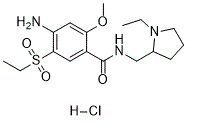This product is for research use only, not for human use. We do not sell to patients.

| Size | Price | Stock |
|---|---|---|
| 500mg | $750 | To Be Confirmed |
| 1g | $1250 | To Be Confirmed |
| 5g | $3375 | To Be Confirmed |
Cat #: V11154 CAS #: 81342-13-4 Purity ≥ 99%
Description: Amisulpride HCl (Barhemsys; Solian; Amazeo; Aminosultopride; Amipride; Amival; Deniban; Amisulprida; Soltus; DAN-2163; Sulpitac; Sulprix), the hydrochloride salt of Amisulpride, is an atypical antipsychotic medication approved for treating psychosis in schizophrenia and episodes of mania in bipolar disorders.
Publications Citing InvivoChem Products
Product Promise

- Physicochemical and Storage Information
- Protocol
- Related Biological Data
- Stock Solution Preparation
- Quality Control Documentation
| Molecular Weight (MW) | 405.94 |
|---|---|
| Molecular Formula | C17H28ClN3O4S |
| CAS No. | 81342-13-4 |
| Protocol | In Vitro | Amisulpride hydrochloride is an atypical dopamine D2/D3 receptor antagonist with Kis of 2.8 and 3.2 nM for human dopamine D2 and D3, respectively. Amisulpride hydrochloride (100 nM) inhibits quinpirole-elicited [3H]thymidine incorporation with an IC50 value of 22±3 nM (n=3). Amisulpride hydrochloride slightly but significantly increases [3H]dopamine release from slices of the rat striatum (S2/S1=0.88±0.04 under control conditions, n=6; 1.04±0.08 in the presence of 100 nM Amisulpride hydrochloride,n=4; P<0.05) and opposes the inhibitory effects of 7-OH-DPAT in both brain areas |
|---|---|---|
| In Vivo | Only the highest dose of Amisulpride hydrochloride (100 mg/kg) significantly reduces dopamine levels in the striatum or limbic system. Amisulpride hydrochloride significantly increases the synthesis of dopamine in the rat striatum and limbic system at doses of 20 and 100 mg/kg. Amisulpride hydrochloride (0.5 to 75 mg/kg) fails to provoke an additional increase in dopa accumulation in the striatum but slightly accelerates, at 75 mg/kg, dopamine synthesis in the limbic system. In comparison with vehicle-treated controls, Amisulpride hydrochloride (10 mg/kg) increases extracellular dopamine levels. The administration of Amisulpride hydrochloride (0.5 to 15 mg/kg s.c.) provokes a time- and dose-dependent increase in the stimulation-evoked dopamine release. Amisulpride hydrochloride decreases striatal ACh levels significantly at 30 and 100 mg/kg (87.5% and 56.3% of control levels, respectively) |
| Solvent volume to be added | Mass (the weight of a compound) | |||
|---|---|---|---|---|
| Mother liquor concentration | 1mg | 5mg | 10mg | 20mg |
| 1mM | 2.4634 mL | 12.3171 mL | 24.6342 mL | 49.2684 mL |
| 5mM | 0.4927 mL | 2.4634 mL | 4.9268 mL | 9.8537 mL |
| 10mM | 0.2463 mL | 1.2317 mL | 2.4634 mL | 4.9268 mL |
| 20mM | 0.1232 mL | 0.6159 mL | 1.2317 mL | 2.4634 mL |
This equation is commonly abbreviated as: C1 V1 = C2 V2
- (1) Please be sure that the solution is clear before the addition of next solvent. Dissolution methods like vortex, ultrasound or warming and heat may be used to aid dissolving.
- (2) Be sure to add the solvent(s) in order.




































